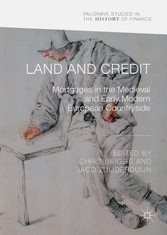Suchen und Finden
Service

Land and Credit - Mortgages in the Medieval and Early Modern European Countryside
Chris Briggs, Jaco Zuijderduijn
Verlag Palgrave Macmillan, 2018
ISBN 9783319662091 , 350 Seiten
Format PDF, OL
Kopierschutz Wasserzeichen
Acknowledgements
6
Contents
7
Editors and Contributors
9
Abbreviations
13
List of Figures
14
List of Tables
16
Chapter 1 Introduction: Mortgages and Annuities in Historical Perspective
18
1.1 Mortgage Contracts and Mortgage Law: Security, but for Whom?
20
1.2 Mortgage Credit: Winners and Losers
24
1.3 Beyond Europe: Mortgages and Development
29
1.4 Contents of the Volume
30
Bibliography
32
Chapter 2 Mortgages and the English Peasantry c.1250–c.1350
34
2.1 Introduction
34
2.2 A Wider Search for Mortgages
39
2.3 Why Were Mortgages Rare Overall?
48
2.3.1 Usury
49
2.3.2 Property Rights
50
2.3.3 Were the Mortgage Terms Too Disadvantageous to Borrower/Mortgagor?
52
2.4 Did the Scarcity of the Mortgage Have a Negative Impact on the Rural Credit Market?
54
2.5 Conclusion
57
References
59
Chapter 3 Mortgages Raised by Rural English Copyhold Tenants 1605–1735
63
3.1 Introduction
63
3.2 Dimensions of the Mortgage Borrowing
67
3.3 Profiles of the Copyhold Borrowers and Their Possible Motivation for Using Mortgages
73
3.4 Borrower Case Studies
80
3.4.1 John Moore: Purchase and Refurbishment
80
3.4.2 William Wyatt: Regular Borrowing for Investment
80
3.4.3 Thomas Wyatt: Legacies and Inherited Debt
81
3.4.4 John Collins: Financial Difficulties
81
3.5 The Mortgage Lenders
82
3.6 Relationships Between Borrower and Lender
87
3.7 Lender Case Studies
90
3.7.1 Abigail Rothwell Widow: Lender of £260 to John Godwin of Crawley
90
3.7.2 Susanna Mitchell, Spinster of Hinton Ampner: Lender to Her Brother
91
3.7.3 Simon Hatch, Yeoman of Droxford: Lender to Three Meonstoke Borrowers
92
3.8 Conclusions
92
References
95
Chapter 4 Mortgages and the Kentish Yeoman in the Seventeenth Century
97
4.1 Introduction
97
4.2 The Nature of the Market
100
4.2.1 Growth of the Market
102
4.2.2 Borrowers and Lenders
104
4.2.3 Intermediaries
111
4.3 Terms and Conditions
112
4.3.1 Interest
112
4.3.2 Term
114
4.3.3 Possession
115
4.4 Conveyancing
116
4.4.1 Type of Mortgage Conveyance
116
Mortgage in Fee and Mortgage by Demise
116
Other Types of Mortgage Deed
119
Remortgages and Assignments
119
4.4.2 Enrolment and Registration
120
4.5 Outcomes
121
4.5.1 Forfeiture, Foreclosure and Sale
121
4.5.2 Redemption
123
The Right of Redemption
123
The Equity of Redemption
123
4.5.3 Remedies and Dispute Resolution
124
4.6 Conclusions
125
References
129
Chapter 5 Why the Equity of Redemption?
132
5.1 Introduction
132
5.2 The Purpose of Mortgages
135
5.2.1 Acquisition of Property
135
5.2.2 Obtaining Otherwise Unavailable Credit
138
5.3 Relation of Property and Debt Values
141
5.4 Ancient Inheritance
143
5.5 Relationships Between Mortgagors and Mortgagees
146
5.6 Mortgagees’ Desire for the Property
149
5.7 Variance of Mortgage Terms
150
5.7.1 Continuation upon Interest
150
5.7.2 Late Redemption Beyond Chancery
153
5.8 Conclusion
155
References
161
Chapter 6 Credit and Land: The Jews of Zaragoza 1383–1400
164
6.1 Introduction
164
6.2 Loan Guarantees and Pledges—Theory and Practice
165
6.3 Jewish Lending and Developments in the Credit Market
167
6.3.1 Background—c.1250–1350
167
6.3.2 Previous Studies of Jewish Lending
169
6.3.3 Security
172
6.3.4 Developments in the Credit Markets During the Fourteenth Century
174
6.4 The Jews of Zaragoza, 1383–1400
177
6.4.1 The Lenders
177
6.4.2 Scope of Economic Activities
178
6.4.3 Loan Deeds
179
6.4.4 Analysis of Loans
179
6.4.5 Borrowers
181
6.4.6 Security Underpinning Loans
183
6.4.7 The Terms of Land Pledges
186
6.4.8 Relationship to the Wider Property Business
188
6.5 Conclusions
189
References
192
Chapter 7 Not Only Land: Mortgage Credit in Central-Northern Italy in the Sixteenth and Seventeenth Centuries
195
7.1 Introduction: The Land Rush in Sixteenth-Century Northern Italy
195
7.2 The New Success of an Old Credit Instrument
200
7.3 The Versatile Nature of Censi Consignativi: From a Defensive Instrument to a Driving Force
205
7.4 Concluding Remarks
211
References
215
Chapter 8 Rural Credit Markets in Eighteenth-Century France: Contracts, Guarantees and Land
219
8.1 Introduction
219
8.2 Rural Credit Markets in Early Modern France
220
8.2.1 Circuits of Credit
220
8.2.2 The Main Credit Instruments
222
8.3 A Rural Credit Market in the Eighteenth-Century France
224
8.3.1 A Local Credit Market
224
8.3.2 Obligations in the Seigneurie of Delle
226
8.3.3 Annuities Versus Obligations?
229
8.3.4 Parish Vestries and Annuities
231
8.4 Changes and Challenges in the Second Half of the Eighteenth Century
233
8.4.1 The Ultimate Need for a Guarantee
233
8.4.2 Changes in the Second Half of the Eighteenth Century
237
8.5 Conclusion
240
References
242
Chapter 9 The Use of Perpetual Annuities in Rural Brabant in the Fifteenth and Sixteenth Centuries
246
9.1 Introduction: The Role of Credit in the Rural Economy of Brabant
246
9.2 The Problem of Sources
250
9.3 The Surroundings of Antwerp
251
9.4 The Campine Area
252
9.5 West of Brussels: The Villages of the Manor of Kruikenburg
253
9.5.1 Land and Credit Markets
254
9.6 Conclusion
260
Appendix
262
References
263
Chapter 10 Proactive Peasants? The Role of Annuities in a Late Medieval Communal Society: The Campine Area, Low Countries
266
10.1 Introduction
266
10.2 The Campine Area: Characteristics of a Communal Peasant Region in the Heart of Urbanity
269
10.3 Annuities: The Institutional Context
272
10.4 General Credit Market Trends
276
10.5 The Role of Factor Markets: The Absence of Accumulation
278
10.6 The Absence of Urban Domination
283
10.7 The Role of Factor Markets: Part of a Peasant Strategy
285
10.8 Conclusion
288
References
290
Chapter 11 The Other Fundamental Problem of Exchange: Mortgages, Defaults and Debtor Protection in Sixteenth-Century Holland
294
11.1 Introduction: The Other Fundamental Problem of Exchange
294
11.2 Borrowing on Collateral
297
11.3 A Fine Balance: Debtor Protection in Holland
301
11.4 Conclusion
313
References
317
Chapter 12 Afterword: Mortgages as Mediation Between Kin and Capital
321
12.1 England
326
12.2 Civil Law Areas
329
References
335
Index
338


